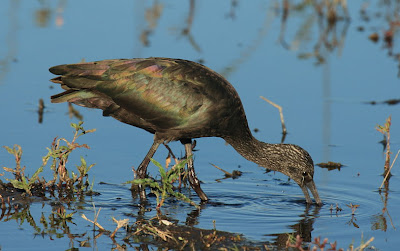July is the month for the African Waterbird Counts, and long-standing transects that have been counted in the Okavango so far are turning up very few birds. The heronries at Xakanaxa, Gadikwe and Gcobega have been surprisingly quiet, and the same applies to other areas. Water at Lake Ngami is deeper and more extensive than at any other time in the recent past, and waterbirds are conspicuous by their absence.
However, along the fringes of inundated floodplains such as the Khwai and Gomoti, birding is much better. Unusually, sizeable flocks of Wattled Cranes are being seen along the Khwai River, an area previously considered marginal for this flodplain specialist. These are likely to be birds forced out of their normal areas by high water, or they may simply be taking advantage of the improved conditions at Khwai. The Gomoti floodplain is teeming with Slaty Egrets, Glossy and African Sacred ibis and a variety of ducks and geese.
 Glossy Ibis probing the shallow floodplain margins (Photo: P Hancock)
Glossy Ibis probing the shallow floodplain margins (Photo: P Hancock)Please keep the BirdLife Office in Maun informed of any build-up of waterbird numbers anywhere in the Okavango Delta system.

No comments:
Post a Comment